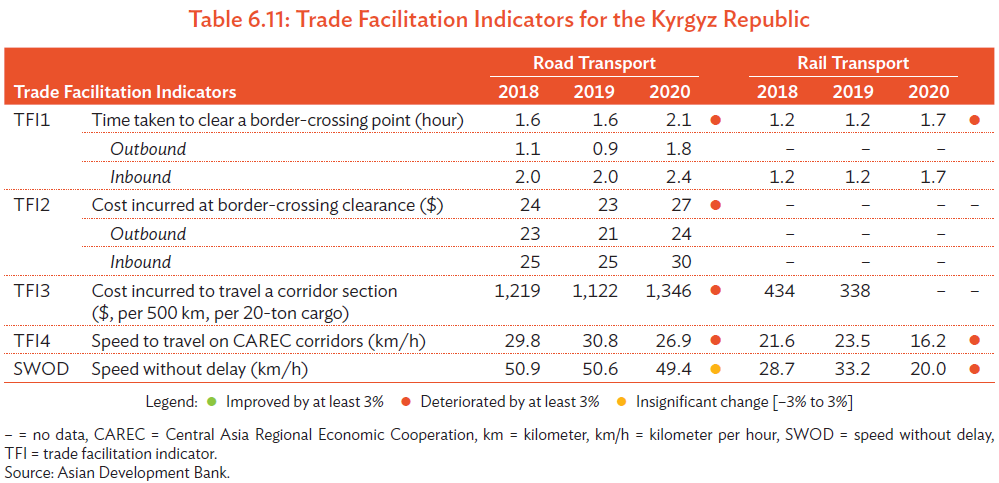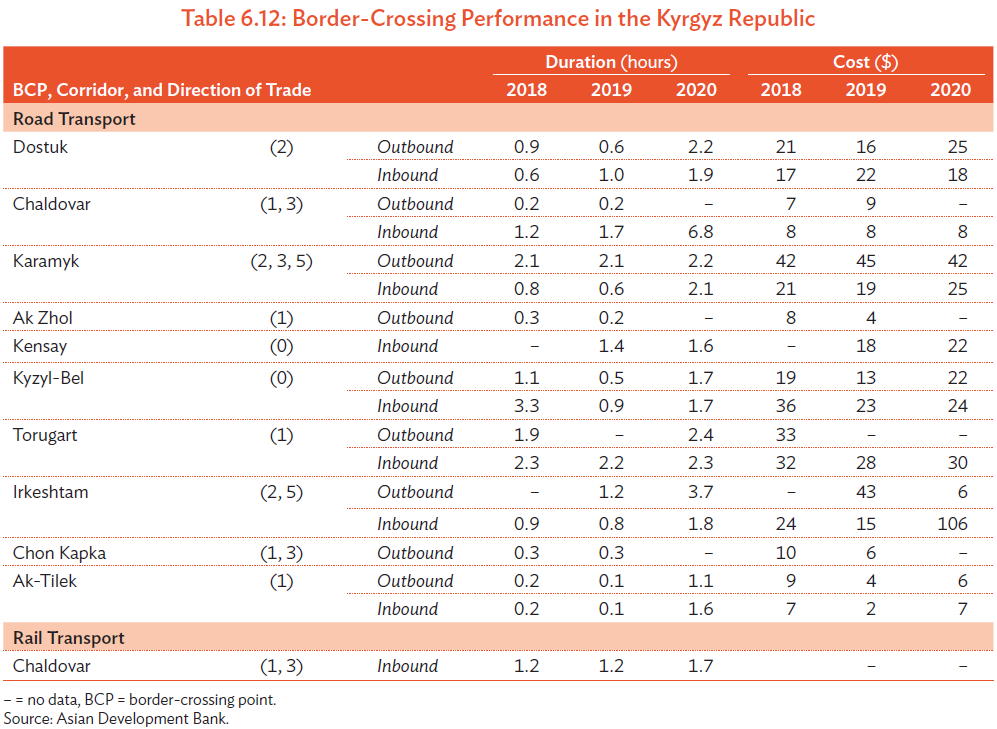The CPMM analysis relies on consistent and comparable data across CAREC countries, despite their inherent differences. This chapter provides an update of the main developments and CPMM data at a national level for each CAREC member country to help explain the trends or resulting outcomes at the regional or corridor level. This country-level analysis examines the policies, regulations, infrastructure, and institutional factors that can affect corridor performance. Pertinent barriers and issues are highlighted, key developments and progress are noted, and high-level recommendations are included.
The 2020 CPMM report introduces the four TFIs at the country level, segregated by road and rail transport, and further separated into outbound and inbound direction for border-crossing time and costs (Tables 6.1–6.22). These data are supplemented by average border-crossing time and cost for BCPs along relevant CAREC corridors. Key CPMM findings, updated trends and developments, and country-specific recommendations are also provided in this chapter.
Key Findings
- Average border-crossing time stepped up from 1.6 hours in 2019 to 2.1 hours in 2020, a 31% increase. The estimate for outbound traffic doubled from 0.9 hours in 2019 to 1.8 hours in 2020.
- Average border-crossing cost increased slightly from $23 in 2019 to $27 in 2020. Total transport cost increased from $1,122 in 2019 to $1,346 in 2020, reflecting a noticeable increase in road freight rate observed in Kazakhstan as well.
- SWOD was 49.4 km/h and SWD was 26.9 km/h in 2020.
- Notable border delays were observed at Chaldovar, where outbound trucks took 6.8 hours on average, and Irkeshtam saw a sizable jump from 0.8 hours to 1.8 hours for inbound trucks.
Trends and Developments
On 24 March 2020, the President of the Kyrgyz Republic declared a state of emergency in Bishkek,
Jalalabad, Kara Suu, Nookat, and Osh. From 25 March to 15 April 2020, restrictions on border crossings
were imposed, disrupting transit business. For instance, the abrupt closures of land borders were not
communicated to many road carriers in the region. Many transport operators, unaware of the latest
status at the BCPs, were stopped upon entry at the Kyrgyz borders. To make matters worse, many trucks
carried agricultural produce but could not cross or enter the Kyrgyz Republic. To alleviate the worsening
food shortage in major cities such as Almaty that rely on food imports, Kazakhstan allowed only two
BCPs at the border to facilitate freight movement, Ak Tilek and Chon Kapka. Nonetheless, from the
middle of May, strict border controls continued due to growing cases of infections, so border-crossing
time became very cumbersome. This pushed up average border-crossing time from 3 to 6 days and the
Kyrgyz operators at times resorted to paying unofficial fees ranging from $300 to $2,500 per truck. After
multiple appeals from the Kyrgyz Republic, the Kazakh border agencies finally relaxed controls and the
situation resumed to normal levels. Chaldybar BCP was closed from 22 March to 15 June 2020. Other
BCPs with Tajikistan and Uzbekistan such as Dostuk, Karamyk, and Kyzyl–Bel continued operation, with
only the driver and shipment subject to sanitation and quarantine measures.


The end of summer brought some relief and there was some perception that the pandemic was under control, so the situation improved slightly. Unfortunately, the resurgence of infections in the fall again resulted in restrictions on cross-border trade. This time, neighboring countries mandated the reverse transcription polymerase chain reaction (RT-PCR) test on drivers. The waiting time for the test results averaged 3 days, and the price ranged between $35 to $50 per driver. Transport operators in the Kyrgyz Republic faced significant impediments at the BCPs located along the border with the PRC. The PRC only allowed 10–15 vehicles to pass through Irkeshtam per day, and 5–8 vehicles at Torugart.
In 2020, work continued to integrate the country deeper into the EAEU, particularly in customs and transportation. The customs code was substituted with the EAEU customs code, which is a supranational law. The government passed a new law to relocate customs controls to the external border with non-EAEU members such as the PRC, Tajikistan, and Uzbekistan. Implementation of 16 of the EAEU international agreements, which are aligned with international conventions and WTO, were in progress. This included recognition of digital documents, automating procedures for filing, and eliminating unnecessary documentary requirements. On transportation, the government drafted and enacted an updated Railways Law. Kazakhstan agreed to increase the list of permissible items for transit to the Russian Federation by 86 commodity groups.
Recommendations
- Financial support for the reverse transcription-polymerase chain reaction test. Many countries have offered support measures to individuals and businesses. The package in the Kyrgyz Republic could consider financial assistance for international transport operators in partial or full subsidies for the laboratory fees incurred to complete the RT-PCR testing.
- Vaccination for frontline workers. Frontline workers refer to individuals who face increased risk of infection due to the nature or location of their work. For instance, drivers moving international freight as well as staff working at the BCPs would fall under this category. A possible next step is for members within the CAREC region to explore mutual acceptance of vaccination, which could begin within the Central Asian republics first before expanding to cover other neighboring countries. Vaccinated workers can then be exempted from the mandatory RT-PCR test at BCPs, thus avoiding the need to wait for 3 days at the border.
- Negotiations with the PRC authorities. CAREC members countries, particularly Kazakhstan, the Kyrgyz Republic, and Tajikistan, generally face more stringent border restrictions with the PRC. Kazakhstan has already started such discussion at the end of December 2020 as the problem worsened at Nur Zholy and Dostyk.
- Develop cold chain infrastructure. Agricultural products such as those under HS07 (vegetables) and HS08 (edible fruits and nuts) are major export items in the CAREC region, including the Kyrgyz Republic. A compelling motivation is that net exporters such as the Kyrgyz Republic, Tajikistan, and Uzbekistan tend to harvest similar products at the same time; thus, the market is flooded with a large supply of the same item, leading to price decrease. At off-peak season, the price increases significantly, but the Kyrgyz Republic could not produce enough to meet domestic and export demand. For instance, Kazakhstan has to import apples from Belarus and Poland in the off-peak season, during which the price differential with the regional supply is substantial. Operating a network of cold chain facilities would enable the Kyrgyz Republic to stabilize supply so that consistent exports all year round would be possible.
